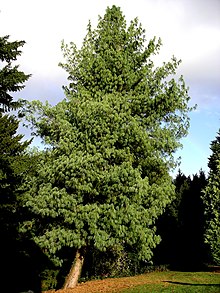Blue Pine
| Pinus wallichiana | |
|---|---|
 |
|
| Tree at Tortworth Court arboretum | |
| Scientific classification | |
| Kingdom: | Plantae |
| Division: | Pinophyta |
| Class: | Pinopsida |
| Order: | Pinales |
| Family: | Pinaceae |
| Genus: | Pinus |
| Subgenus: | Strobus |
| Species: | P. wallichiana |
| Binomial name | |
|
Pinus wallichiana A. B. Jacks. |
|
Pinus wallichiana is a coniferous evergreen tree native to the Himalaya, Karakoram and Hindu Kush mountains, from eastern Afghanistan east across northern Pakistan and north west India to Yunnan in southwest China. It grows in mountain valleys at altitudes of 1800–4300 m (rarely as low as 1200 m), between 30 m and 50 m in height. It favours a temperate climate with dry winters and wet summers.
This tree is often known as Bhutan pine, (not to be confused with the recently described Bhutan white pine, Pinus bhutanica, a closely related species). Other names include blue pine,Himalayan pine and Himalayan white pine. In the past, it was also known by the invalid botanic names Pinus griffithii McClelland or "Pinus excelsa" Wall., Pinus chylla Lodd. when the tree became available through the European nursery trade in 1836, nine years after Nathaniel Wallich first introduced seeds to England.
The leaves ("needles") are in fascicles (bundles) of five and are 12–18 cm long. They are noted for being flexible along their length, and often droop gracefully. The cones are long and slender, 16–32 cm, yellow-buff when mature, with thin scales; the seeds are 5–6 mm long with a 20–30 mm wing.
Typical habitats are mountain screes and glacier forelands, but it will also form old-growth forests as the primary species or in mixed forests with deodar, birch, spruce, and fir. In some places it reaches the tree line.
The wood is moderately hard, durable and highly resinous. It is a good firewood but gives off a pungent resinous smoke. It is a commercial source of turpentine which is superior quality than that of P. roxburghii but is not produced so freely.
...
Wikipedia

